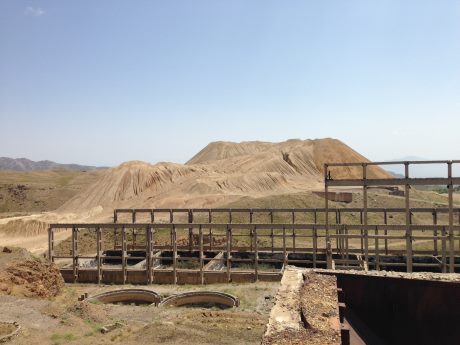A new fund set up by the European Bank for Reconstruction and Development (EBRD) at the request of the European Commission will finance projects to rehabilitate former uranium mines and processing sites in Central Asia.
 |
| Legacy sites such as Tajikistan's Yellow Hill have seen little or no remediation (Image: Harlander/EBRD) |
The European Commission is providing the Environmental Remediation Account for Central Asia with an initial €8 million ($9 milliion) in funding, with more under consideration. The money will be used to finance the remediation of sites in the Kyrgyzstan, Tajikistan and Uzbekistan that have already been identified as "high priority".
Central Asian mining operations were an important source of uranium in the former Soviet Union, Most of the mines in Kyrgyzstan, Tajikistan and Uzbekistan had closed by the mid-1990s, by which time large amounts of tailings contaminated with radioactive material accumulated during their operations had been placed in waste dumps or tailing sites. Very little remediation of either mining sites or tailings storage facilities has been undertaken since Soviet mining ceased.
The accumulated contaminated material is a threat to the environment and also to the health of the population, according to the EBRD. Many of the uranium legacy sites are concentrated along the tributaries to the Syr Darya River which runs through the Fergana Valley, a densely populated region which is also an agricultural centre shared by Kyrgyzstan, Tajikistan and Uzbekistan.
EBRD director for nuclear safety Vince Novak described the new fund as a recognition of the urgent need for action regarding the Central Asian uranium sites and of EBRD's nuclear decommissioning expertise and know-how. "We welcome the initiative by the European Commission and at the same time invite other donors to join this highly important effort," he said.
The EBRD has been working closely with the European Commission on nuclear safety programs since the 1990s and can claim significant expertise in the management of multilateral funds and the efficient delivery of large nuclear safety assistance programs. It has been managing nuclear safety and decommissioning funds on behalf of the international community since 1992, when the G7 created the Nuclear Safety Account to deal with the legacy of Soviet-era nuclear facilities and equipment.
The bank's Nuclear Safety Department manages the Chernobyl Shelter Fund as well as international decommissioning support funds for Bulgaria, Lithuania and the Slovak Republic and the nuclear window of the Northern Dimension Environmental Partnership, which funds projects to mitigate the legacy of the operation of nuclear-powered ships and submarines of Russia's northern fleet.
The European Commission launched its TACIS (Technical Aid to the Commonwealth of Independent States) nuclear safety program in the wake of the 1986 Chernobyl accident to provide nuclear safety assistance mostly to projects in Russia and Ukraine. Since 2007, it has widened its nuclear safety assistance and cooperation to third-party countries under the Instrument for Nuclear Safety Cooperation (INSC), which had a total budget allocation of €524 million ($597 million) for 2007-2013. A new INSC covering 2014-2020 was adopted in 2013, with a total budget of €225 million ($256 million).
Researched and written
by World Nuclear News





_91467.jpg)
_47120.jpg)
_16439.jpg)





